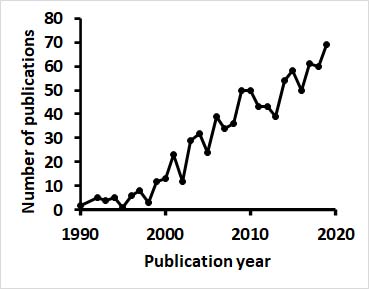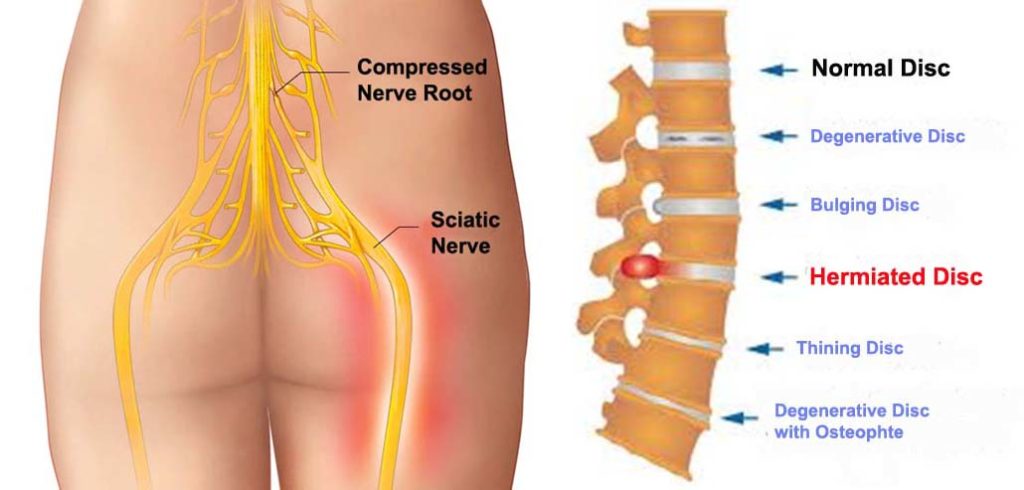Acupuncture for Low Back Pain and Sciatica
1. Acupuncture for low back pain
Back pain is one of the top reasons people seek medical treatment because nearly 8 out of every 10 people will have low back pain at some point in life. Among the more commonly used complementary and alternative medicine treatment strategies, acupuncture is used frequently in patients for low back pain. It is also the No. 1 reported reason for patient to seek acupuncture. During recent 3 decade, number of research publications on acupuncture for low back pain have been increased by 30 folds. Those research works provider planty scientific evidences to support using acupuncture for low back pain treatment.

A 2015 literature systematically reviews 16 randomized controlled clinical trials involved with 11682 patients. This review found that acupuncture is consistently to provide superior pain relief for chronic low back pain comparing with sham acupuncture, no treatment, conventional treatment including physical therapy, exercise and medication. Other 2016 literature systematically reviews 7 randomized controlled clinical trials involved with 7958 patients. This review found that acupuncture significantly reduced pain intensity immediately and last 12 weeks after treatment. This reviews also reported acupuncture provided not only greater pain relief compared with medications (nonsteroidal anti-inflammatory drugs, muscle relaxants, or analgesics), but also improved body function.
A 2019 literature systematically reviews 31 randomized controlled clinical trials involved with 6656 patients. The meta-analysis1 results indicated acupuncture is clinically superior to sham acupuncture in pain reduction for patients with chronic low back pain defined as lasting longer than 3 months, comparing with other treatments including sham acupuncture, no treatment, transcutaneous electrical nerve stimulation, medications, usual care.
Because acupuncture’s effective for low back pain, The American College of Physicians issued a clinical practice guideline recommending acupuncture as a first-line therapy for acute and chronic nonradicular low back pain along with other nondrug therapy including stretching, heat application, massage, and manual spinal manipulation.
2. Acupuncture for sciatica
More than 52 % lower back pain patients are associated with sciatica. Research have shown that acupuncture is an effective treatment to relief sciatica.
(1). Clinic Studies
A 2017 literature systematically reviews 14 studies published an found that acupuncture obtains a better pain alleviating result for sciatica. Right now, other two clinic trails investigated acupuncture for sciatica are preforming. First study is a double-blinded, randomized controlled clinical trial involved with 90 patients diagnosed with disc-related sciatica. This clinical trial began at 2017 and aims using acupuncture immediate relief of herniated lumbar disc-related sciatica. Other randomized, blind, sham-controlled clinical trial is investigating effect and neurophysiological mechanism of acupuncture in patients with chronic sciatica.

Sciatica is commonly due to a herniated disc compresses part of the nerve root. How no-surgical treatment such as acupuncture physically relief the compresses of herniated disc? Clinic research and case reports have been well documented that intervertebral herniated disc can spontaneous disappearance or regression when patient no longer had leg pain or physical findings of nerve root tension after no-surgical treatments. For example, research conducted by Altun found the patients with lumbar disc hernia had benefit from no surgical treatment and bed rest. Radiologic improvement was observed simultaneously on MRI scans. The average duration until symptomatic recovery and/or regression of lumbar disc hernia symptoms was 13.6 months.
(2) Case Report
The MIR image below showed spontaneous regression of a lumbar disk herniation after 6 month no surgical treatment. This MIR is from a case report by Michael J. Monument. Patient is 57-year-old man with left-sided leg pain of six months. MRI shown a large left-sided paracentral disk herniation at the L4–L5 disk space. Herniated disk compresses the traversing L5 nerve root, which was consistent with the patient’s symptoms (Figure A). The After 6 month no surgical treatments, the patient no longer had leg pain and physical findings of nerve root tension. The second MRI showed substantial resolution of the herniated L4 andL5 disk (Figure 1B).
The MRI image above shows spontaneously disappearing lumbar disc protrusion after no surgical treatment. This MRI is from a case repot reported by Ushewokunze. Patient is 45-year-old woman with a 9-month history of low backache and bilateral sciatica. Her MRI scan revealed a large central herniation disc at the L4/5 level (Figure A). After she received 2 months no-surgical treatment, her symptoms had completely resolved. The repeat MRI showed no major disc herniation or nerve root compression. The disc prolapse that was present on the previous scan had completely disappeared (Figure B).


3. Mechanism of disappearance or regression of hernia disc
It still remains unresolved that the exact mechanism of spontaneous disappearance or regression of lumbar disc hernia after no surgical treatment. Proposed mechanisms include mechanical retraction of the herniated nucleus, gradual dehydration, shrinkage of the disk, resorption of the disk, enzymatic degradation of herniated disk material, neovascularisation and infiltration by inflammatory cells such as macrophages, granulocytes, and lymphocytes.
The researches also found that neurophysiological mechanism is involved in acupuncture treatment for chronic sciatica. Several studies on neuroimaging showed some changes in morphology and functional connectivity of the brain in patients with neuropathic pain such as from herniated intervertebral disk and sciatica, indicating decreased functional connectivity of the dorsolateral prefrontal cortex and anterior cingulate cortex in chronic sciatica. Acupuncture correlated with a reverse in the abnormal default mode network. Another study showed that acupuncture treatments recovered decreased functional connectivity of DLPFC and ACC in patients with chronic sciatica.
4. References
1.Kim KW, Park K, Park HJ, Jahng GH, Jo DJ, Cho JH, Song EM, Shin WC, Yoon YJ, Kim SJ, Eun S, Song MY, Effect and neurophysiological mechanism of acupuncture in patients with chronic sciatica: protocol for a randomized, patient-assessor blind, sham-controlled clinical trial. Trial. 2019 Jan 16;20(1):56. .PubMed
2. Lee IS, Cheon S, Park JY. Central and Peripheral Mechanism of Acupuncture Analgesia on Visceral Pain: A Systematic Review. Evid Based Complement Alternat Med. 2019 May 2;2019:1304152.PubMed
3.Xiang A, Xu M, Liang Y, Wei J, Liu S.Immediate relief of herniated lumbar disc-related sciatica by ankle acupuncture: A study protocol for a randomized controlled clinical trial. Medicine (Baltimore). 2017 Dec;96(51):e9191.PubMed
4.Wang Y, Lei J, Gupta M, Peng F, Lam S, Jha R, Raduenz E, Beitz AJ, Gupta K1.Electroacupuncture in conscious free-moving mice reduces pain by ameliorating peripheral and central nociceptive mechanisms. Sci Rep. 2016 Sep 30;6:34493.PubMed
5. Chia-Ming Yen, Tong-Chien Wu, Ching-Liang Hsieh, Yu-Wei Huang, and Yi-Wen Lin, Distal Electroacupuncture at the LI4 Acupoint Reduces CFA-Induced Inflammatory Pain via the Brain TRPV1 Signaling Pathway, Int J Mol Sci 2019 Sep 10;20(18):4471.PubMed
6. Yuheng Li, Zongping Fang , Nan Gu, Fuhai Bai, Yongyuan Ma, Hailong Dong 1, Qianzi Yang 1, Lize Xiong 1, doi: 10.2147/JPR.S205987. eCollection 2019.Inhibition of Chemokine CX3CL1 in Spinal Cord Mediates the Electroacupuncture-Induced Suppression of Inflammatory Pain, J Pain Res 2019 Sep 4;12:2663-2672.PubMed
7. Roselyn Clemente Fuentes, Brooke Organ, Julie Creech, Christine M Broszko, Joan Nashelsky, Acupuncture for Low Back Pain, Can Fam Physician 2020 Mar;66(3):186-187.PubMed
8.Michael J Monument , Paul T Salo, Spontaneous Regression of a Lumbar Disk Herniation,CMAJ 2011 Apr 19;183(7):823.PubMed
9. Ruixin Zhang, Lixing Lao, Ke Ren, Brian M Berman,Mechanisms of Acupuncture-Electroacupuncture on Persistent Pain, Anesthesiology 2014 Feb;120(2):482-503.PubMed
10. Shungu Ushewokunze, Naeem Abbas, Ronan Dardis, Ian Killeen, Spontaneously Disappearing Lumbar Disc Protrusion, Br J Gen Pract 2008 Sep;58(554):646-7.PubMed
